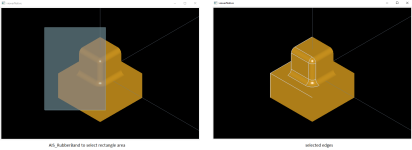Hi Bros, I'm LJK。
I seem to have a problem now。
I've been using OCCT recently to filter visible faces in a certain direction。
I was going to use the method of intersecting the ray with the plane to get the faces that I can see in the direction I want。
Today,I just found out that there is Face culling function on OpenGL, after I choose any viewing direction, through Face culling, I can get all the faces I see in this direction.
So, I get a question:Is there a similar method in OCCT to get all the visible faces of a model in a certain view?I'm trying to solve this problem, but I don't have any idea at the moment。
The viewing direction is similar to the camera angle of view, and all the faces that can be seen in the camera's angle of view are the faces I need.

I seem to have a problem now。
I've been using OCCT recently to filter visible faces in a certain direction。
I was going to use the method of intersecting the ray with the plane to get the faces that I can see in the direction I want。
Today,I just found out that there is Face culling function on OpenGL, after I choose any viewing direction, through Face culling, I can get all the faces I see in this direction.
So, I get a question:Is there a similar method in OCCT to get all the visible faces of a model in a certain view?I'm trying to solve this problem, but I don't have any idea at the moment。
The viewing direction is similar to the camera angle of view, and all the faces that can be seen in the camera's angle of view are the faces I need.


